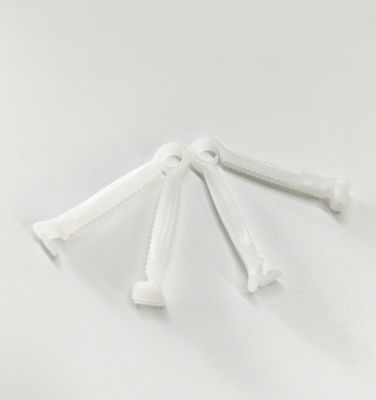-
Highlight
Sterilized umbilical cord clamp clipper
,Newborn baby umbilical cord clamp clipper
-
Place Of OriginChina
-
Disinfecting TypeEOS
-
SizeL, S
-
StockNo
-
Shelf Life5 Years
-
MaterialPP
-
Quality CertificationCE
-
Instrument ClassificationClass I
-
PackageBlister Bag
-
ColorWhite
-
SampleAvailable
-
SterileEO Sterilized
-
OEMSupport
-
Place of OriginChina
-
Brand NameHenan
-
CertificationCE
-
Model NumberL, S
-
Minimum Order Quantity5000pcs
-
PriceNegotiable
-
Packaging DetailsIndividual Packaging
-
Delivery Time24-30 days
-
Payment TermsL/C, T/T, Western Union
-
Supply Ability50000000pcs per month
Sterilized Umbilical Cord Clamp Clipper For Newborn Baby
Sterilized umbilical cord clamp clipper for newborn baby
Product description
- Material and Design: Umbilical Cord Clamps are typically made from medical-grade plastic or silicone, ensuring they are gentle on the newborn and safe to use. They are designed to be simple and practical for easy application.
- Function: The primary function of an Umbilical Cord Clamp is to secure and cut the umbilical cord after a newborn's birth, preventing bleeding and infection. They ensure the safe and secure fixation of the cord until it naturally heals.
- Disposable: Most Umbilical Cord Clamps are disposable to maintain sterility and minimize the risk of cross-contamination.
- Safety: These clamps must adhere to medical device safety standards to ensure they do not cause harm to the newborn during the cord handling process.
- Applications: Umbilical Cord Clamps are widely used in obstetric healthcare facilities, hospital delivery rooms, and home births, making them essential equipment after a newborn's birth.
- Ease of Use: They are user-friendly and are typically applied by healthcare professionals immediately after a newborn's birth to ensure timely and proper cord handling.
In summary, Umbilical Cord Clamps are critical medical devices in obstetric care, ensuring the safe handling of a newborn's umbilical cord to prevent infection and promote the newborn's health and well-being.
![]()
Disposal Procedure
- Removal: After the umbilical cord has healed and the clamp is no longer needed, carefully remove it following standard protocols.
- Disposal: Used Umbilical Cord Clamps are classified as medical waste and should be disposed of according to healthcare facility guidelines and local regulations.
- Sterilization: If the clamp is meant for single-use only, do not attempt to sterilize or reuse it. Dispose of it in designated biohazard waste containers.
- Biohazard Waste: Since these clamps may have come into contact with bodily fluids, they are considered biohazardous waste. Place them in biohazard waste containers for safe disposal.
- Medical Waste Management: Healthcare facilities have specific procedures for managing medical waste, including used medical devices like cord clamps. Ensure compliance with these protocols.
- Compliance: Adhere to regulations for medical waste disposal to maintain a safe and hygienic environment for both healthcare workers and patients.
Following proper disposal procedures for used Umbilical Cord Clamps is crucial to prevent the spread of infections and maintain a clean healthcare environment. Healthcare facilities typically have guidelines in place to handle and dispose of these clamps and other medical waste appropriately.
![]() FAQ
FAQ
1.How long do you leave a clamp on your umbilical cord?
By the time the baby goes home from the hospital, the cord is beginning to dry and wither. The clamp can be removed when the cord is completely dry. The cord falls off by itself in about two to three weeks.
2.What are umbilical cord clamps?
The clamp helps stop bleeding from the blood vessels in the umbilical cord. A medicine is sometimes applied to the cord as part of a baby's first care. This may be a purple dye or another type of antiseptic. But it's now advised to keep the cord dry (dry cord care).
3.Why do humans clamp the umbilical cord?
Immediate umbilical cord clamping has traditionally been carried out along with other strategies of active management in the third stage of labor in an effort to reduce postpartum hemorrhage. Consequently, concern has arisen that delayed umbilical cord clamping may increase the risk of maternal hemorrhage.
4.Is it better to clamp or tie the umbilical cord?
A cord tie is an alternative to the plastic clamps used to clamp the umbilical cord before cutting it. Why use a cord tie? Some people prefer to use a cord tie for a number of reasons, including: It's softer against baby's skin.
5.What happens if you don't clamp the umbilical cord?
What are the benefits of waiting to clamp the umbilical cord? If the umbilical cord is not clamped and cut right after the baby is born, more blood flows through the umbilical cord to the baby. This extra blood may lower the chance of your baby having low iron levels at 4 to 6 months of life.
6.Why wait to clamp the umbilical cord?
Waiting to clamp the umbilical cord for 2–3 min, or until cord pulsations cease, allows a physiological transfer of placental blood to the infant (the process referred to as “placental transfusion”), the majority of which occurs within 3 min.





